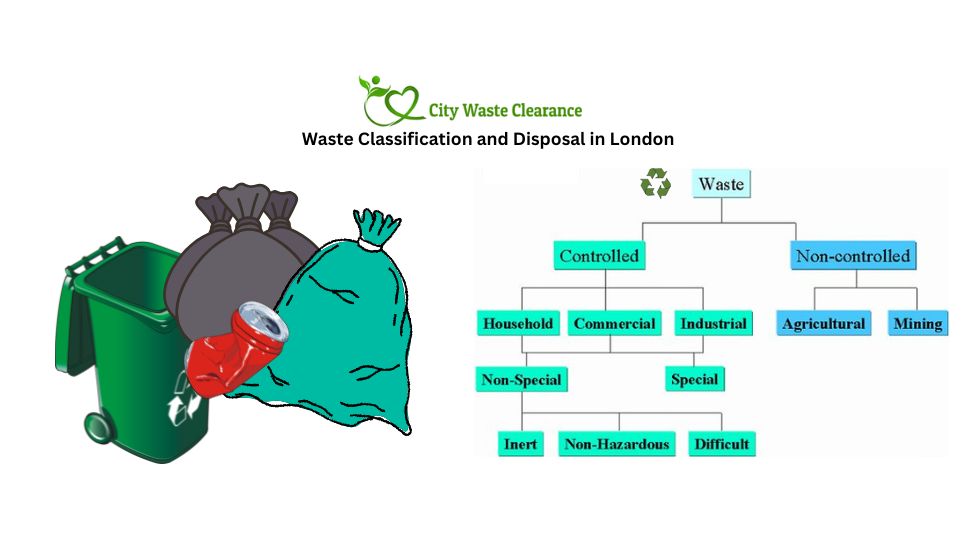Waste classification in London involves categorizing waste into specific types for proper disposal. Disposal methods ensure environmental safety and regulatory compliance.
London’s waste classification system is designed to manage various waste types efficiently. Categories include household, commercial, hazardous, and recyclable waste. Proper sorting helps in recycling and reduces landfill usage. Authorities provide guidelines and bins for different waste types. Businesses and residents must follow these rules to avoid fines and contribute to sustainability.
Specialized services handle hazardous waste to prevent harm. Recycling centers and collection services are available throughout the city. This system promotes cleanliness and environmental protection. By adhering to waste classification and disposal guidelines, London aims for a greener and cleaner environment.
Introduction To Waste Classification
Waste classification helps us understand the different types of waste. This makes it easier to manage and dispose of waste properly. In London, proper waste classification helps keep the city clean and safe. It also helps protect our environment.
Classifying waste is important for many reasons. It helps in recycling and reducing landfill waste. Proper classification helps in saving natural resources. It ensures harmful waste is handled safely. This protects both humans and wildlife from harm. It also helps in reducing pollution. Proper waste classification can save money by recycling valuable materials. It helps in following laws and regulations. This keeps London a clean and green city.
London generates different types of waste. These include household waste, commercial waste, industrial waste, and hazardous waste. Household waste comes from homes. It includes food scraps, paper, and plastic. Commercial waste comes from businesses. It includes packaging and office supplies. Industrial waste comes from factories. It includes chemicals and machinery parts. Hazardous waste includes batteries, paint, and medical waste. Each type of waste requires special disposal methods.
Household Waste
Plastic bottles, glass jars, and aluminum cans are common household items. Paper products like newspapers and cardboard boxes are also found in most homes. Old clothes and textiles often pile up in closets. Kitchen waste includes food scraps and vegetable peels.
Plastic bottles should go in the recycling bin. Glass jars and aluminum cans belong in separate recycling containers. Paper products need to be clean before recycling. Old clothes can be donated or placed in textile recycling bins. Kitchen waste like vegetable peels should be composted if possible.
Commercial Waste
Businesses in London produce different types of waste. General waste includes everyday items like paper and plastic. Recyclable waste covers items like glass and cardboard. Hazardous waste includes chemicals and batteries. Electronic waste or e-waste involves old computers and phones. Organic waste comes from food scraps and garden clippings. Each type requires special handling.
London has strict rules for waste disposal. Businesses must separate their waste types. Hazardous waste needs special containers. Recyclables should go to recycling centers. Fines are given for improper disposal. Each business must follow these rules to avoid penalties. Waste collection services can assist with this process.
Hazardous Waste
Hazardous waste can harm humans and the environment. Examples include batteries, chemicals, and medical waste. Look for warning labels like “toxic” or “flammable” on items. Check if the waste is corrosive, reactive, or toxic. Knowing these signs helps identify hazardous waste.
Store hazardous waste in strong, sealed containers. Label the containers clearly. Use designated disposal sites for hazardous waste. Don’t mix hazardous waste with regular trash. Call local waste services for help.
Recycling Initiatives
London has many recycling programs. These programs help reduce waste. They also keep the city clean. Many people join these programs. They recycle paper, glass, and plastic. Schools teach kids about recycling. This helps them learn early. Businesses also take part. They recycle office waste. This includes paper and old electronics.
Recycling has many benefits. It saves natural resources. It also reduces the amount of waste in landfills. Recycling helps the environment. It saves energy too. Making new products from old ones uses less energy. This means less pollution. Recycling also creates jobs. Many people work in recycling centers. This helps the economy.
Future Of Waste Management
New technologies help in better waste management. Robots sort waste faster than humans. Smart bins can tell when they are full. Drones can monitor landfill sites. AI helps in predicting waste patterns. These advances make waste management more efficient.
Sustainability is key in waste management. Recycling reduces waste going to landfills. Composting turns organic waste into useful soil. Energy recovery converts waste to energy. Zero waste aims to eliminate waste entirely. These goals help in protecting the environment.
Frequently Asked Questions
What Are The Waste Classifications In London?
Waste in London is classified like household, commercial, hazardous, and recyclable waste.
How To Dispose Of Hazardous Waste?
Hazardous waste should be taken to designated disposal sites or booked for special collection services.
Can I Recycle Electronic Waste In London?
Yes, electronic waste can be recycled at specific recycling centers or through special collection services.
Conclusion
Proper waste classification and disposal in London are essential. They help protect the environment and public health. By following local guidelines, residents can contribute to a cleaner city. Always separate recyclables, compostables, and non-recyclables correctly. Together, we can make London a greener, more sustainable place to live.


